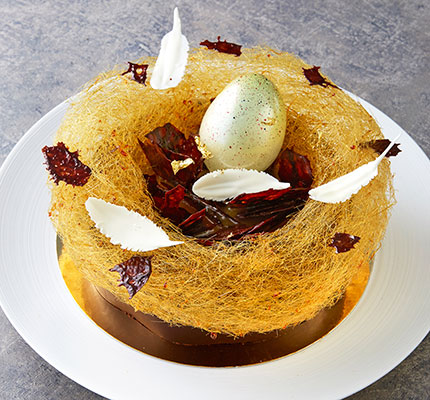Easter chocolate mousse cake
A true chocolate showstopper for any Easter table. This gorgeous centrepiece has a flourless chocolate sponge base topped with rich chocolate mousse and a spun sugar nest
-
Prep:1 hrs
Cook:50 mins
plus 2 1/2 hours chilling - Serves 8
- A challenge
Nutrition per serving
-
kcal 567
-
fat 30g
-
saturates 17g
-
carbs 63g
-
sugars 54g
-
fibre 5g
-
protein 9g
-
salt 0.3g
Ingredients
- 3 medium egg yolks (weighing 60g)
- 100g golden caster sugar
- 3 medium egg whites (weighing 60g)
- 25g cocoa powder
- 4 medium egg whites (80g)
- 25g golden caster sugar
- 140g dark chocolate (70% cocoa solids)
- 25g cocoa powder
- 1 medium egg yolk (20g)
- 100g golden caster sugar
- 1 tsp cocoa powder
- 35g butter
- 35g dark chocolate (100% cocoa solids, I used Willie's)
- 25g liquid glucose
- 140g dark chocolate, very finely chopped (70% cocoa solids)
- 100g granulated sugar
- 50g liquid glucose
- zest and juice 1 lemon
- 100ml whipping cream
- white chocolate feathers and spun sugar nest, and a decorative egg (I use a blown sugar egg, but you could use a shop-bought chocolate egg, if you like)
- 18cm cake or pastry ring (4½ cm high, available from amazon.co.uk)
- acetate roll (6cm wide x 40cm long, available from amazon.co.uk)
- food thermometer or temperature probe
- large and small palette knives
Method
Heat oven to 180C/160C fan/ gas 4. Line a baking sheet with baking parchment and sit the cake ring on top. Put the egg yolks in a large bowl. Whisk the egg whites with the sugar in a separate bowl, or a mixer, until stiff peaks form.
Once stiff, use a large metal spoon to stir one-quarter of the whites into the yolks, then pour the mixture back into the remaining egg whites, and gently fold to combine. Sieve in the cocoa powder and gently fold again until just combined.
Pour into the cake ring and level out with a spatula or spoon. Bake for 15-20 mins or until a skewer inserted into the centre comes out clean. Leave to cool in the ring – the middle will sink.
Once the cake has cooled, slide a knife around the inside of the ring to release the cake and lift the ring off. Trim the edge of the cake with scissors. Clean the ring and place it back around the sponge on a cake board, or on a cake stand.
Boil the kettle. In a large clean bowl, or a freestanding mixer, whisk the egg whites and sugar until medium peaks form.
Set a bowl over a pan of gently simmering water and melt the chocolate to around 50C. In a separate bowl, whisk 50ml hot water with the cocoa powder, then add the yolks. Tip onto the melted chocolate, but don’t stir it in yet.
Briskly whisk one-quarter of the egg whites into the melted chocolate and egg yolk mixture – this ensures that the mousse has an even texture. Use a spatula to fold in the remaining egg whites until fully combined.
Pour the mousse onto the sponge, then chill for at least 2 hrs or up to 24 hrs. Meanwhile, make the chocolate croustillant, white chocolate feathers and spun sugar nest, if using (see opposite).
Melt half the chocolate in a bowl over gently simmering water. Once melted, stir in the remaining chocolate, then remove from the heat. Leave to cool for 5 mins. Using a palette knife, spread the chocolate across the acetate band in a thin, even layer to cover. Leave to set for 1-2 mins.
Lift off the cake ring, then wrap the acetate around the cake so that the chocolate touches the mousse. Stick it tightly and hold for a second to make sure it stays in place – don’t worry if it overlaps a little. Chill for 30 mins. Meanwhile, make the butterscotch sauce (see opposite).
To assemble the cake, remove from the fridge and peel off the acetate carefully, breaking off any overlapping chocolate.
Spoon half the lemon butterscotch sauce over the mousse, then top with the spun sugar nest and chocolate feathers, if using. Add the shards of broken chocolate croustillant and a decorative egg, if you like. Serve within 1 hr with the remaining sauce on the side.
Melt 50g chopped white chocolate in a bowl over a pan of gently simmering water. Use a small palette knife to spread a thin layer of the chocolate on a piece of baking parchment in a feather shape. You can set the parchment on the inside of an upturned cake tin to set the chocolate feather in a curved shape, if you like. Once set, peel off the parchment and use a small knife to notch the edges to give them a feathery effect.
Fill the sink with cold water and cover an area of your work surface (about 1m x 50cm) with baking parchment or cling film.Put 150g fondant icing and 20g liquid glucose in a saucepan over a medium heat. Cook until the fondant melts, then increase the heat and bubble until it turns to a deep caramel. Quickly cool down the pan by dipping the base in the cold water in the sink, but make sure no water splashes into the pan. This should stop the sugar from cooking and thicken the caramel slightly. Using 2 forks, pull strands of caramel from the pan, and flick them quickly from a height over your covered work surface to create multiple thin sugar threads. Keep going until you have a large mass – enough to make a nest. If the caramel starts to set, put it back on the heat to soften it a little. Use your hands to shape the sugar threads gently into a loose cylinder, then wrap into a nest shape. Will keep for a couple of days in a cool, dry container. If it comes into contact with any moisture or heat, it will dissolve.
Heat oven to 180C/160C/gas 4. Mix the sugar and cocoa in a bowl. In a small saucepan, gently melt the butter with the chocolate and glucose over a gentle heat. Once melted, whisk in the sugar and cocoa powder mixture and 50ml cold water. Bring to the boil and cook for 30 secs-1 min until slightly thickened.
Spread a third of the mixture onto a piece of baking parchment on a baking sheet. Lay another piece of parchment on top and, using a rolling pin, roll out the croustillant as thin as possible. Set in the freezer for 5 mins until the top sheet of parchment peels off easily. Repeat with the rest of the mixture, or freeze for another day.
Peel off the top layer of parchment and bake in the centre of the oven for 5 mins. When it is bubbling, it’s cooked. Cool completely before breaking into large pieces.
In a saucepan, combine the sugar, liquid glucose and 1 tbsp water. Set over a gentle heat until the sugar dissolves, but do not stir. Once dissolved, bring to the boil and cook until the sugar syrup turns into a caramel and is lightly golden. Warm the lemon zest and juice in the microwave on High for 1 min, then heat the whipping cream in a separate bowl in the microwave on High for 2 mins. Once the caramel is golden, pour in the lemon and cream. Boil for 30 secs, then set aside to cool. Chill in the fridge, covered with cling film, until needed





















